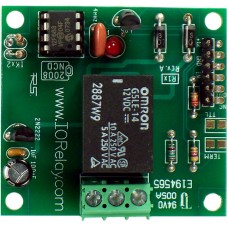RS-232 1-Channel SPDT Relay Controller
RS-232 Serial Relay Controller
Our RS-232 Relay Boards offer a low-cost solution for your computer controlled switching needs. This is a no-frills design that simply allows on/off control of the on-board relay. Read the status of the relay using simple serial commands. Provide +12 Volts DC to the board, and send ASCII character codes to control the relays. Even a no-frills design deserves a high-quality driver stage, and that’s exactly what we put on our Serial Relay Controllers. Fast-reacting flyback diodes help shunt dangerous voltages away from the driver circuit. Features include no-click startup, LED status light, on-board header for power and data connections. Relays can be controlled at 9600 baud and this controller is compatible with ANY computer or microcontroller capable of delivering RS-232 data.
10-Amp SPDT Relay Option
This controller is available with a 10-Amp relay option, allowing control of higher-power loads up to an absolute maximum of 240VAC at 10 Amps. Ideal for general purpose switching applications, this relays is focused on power-switching, and should never be used for low-power signals due to a higher On resistance of up to 150 Ohms when relay contacts are new (contact resistance drops to less than 1 Ohm after break-in period). The 10-Amp relay is of the SPDT variety, which provides Common (C), Normally Open (NO), and Normally Closed (NC) connections. Common is connected to NC when the relay is off. Common disconnects from NC and connects to NO when the relay is activated. All connections are made via screw terminals, capable of accepting up to 12 AWG wire.
5-Amp SPDT Relay Option
This controller is available with a 5-Amp relay option, allowing control of higher-power loads up to an absolute maximum of 240VAC at 5 Amps. Ideal for general purpose switching applications, this relays is focused on power-switching, and should never be used for low-power signals due to a higher On resistance of up to 150 Ohms when relay contacts are new (contact resistance drops to less than 1 Ohm after break-in period). The 5-Amp relay is of the SPDT variety, which provides Common (C), Normally Open (NO), and Normally Closed (NC) connections. Common is connected to NC when the relay is off. Common disconnects from NC and connects to NO when the relay is activated. All connections are made via screw terminals, capable of accepting up to 12 AWG wire.
Features
- 9600 Baud Operation
- Relay Status LEDs
- Quick Connect Terminal Blocks
- TTL RS-232 Inputs
- +12 Volt Operation, 2-Wire RS-232
- Choose a 5 or 10 Amp Relay
- Overkill Transistor Drivers
- No-Click Power-up
- 2-Way Communication Capable
Enter the code in the box below:


